After our dive on the Mohawk on Saturday, we hoped to get out again on Monday, July 5th. As it turned out, Beth and I didn’t have enough tanks to do a two tank dive so we decided to go out and do one tank. Our choice of dive sites was made a little easier on Sunday when my friend’s wife, Toni, asked when I was going to start getting mussels again. She and her husband, Charlie, really loved them when we brought them last year.
Our favorite go-to site for blue mussels is the Dykes. It has other names like the Steel Schooner and the Five-masted Schooner. The Dykes is a 305’ long x 35’ wide schooner barge. It was built in 1919 in Baltimore, Maryland. It’s last job was as a sludge barge for the New York City DEP. She was retired in 1959 and sunk in 1983 on the Sea Girt Artificial Reef off Sea Girt, New Jersey. You can read more about the Dykes on Rich Galiano’s NJScuba.net web site. Click here to go direct to the Dykes information page.
The marine weather had called for 10-15 knot winds with gusts to 20 knots. We decided to meet at the boat at 7:00 am to try and get out before the winds started blowing. As often happens, the weather forecast was not to close. As we sailed out of Manasquan Inlet, the seas were flat. We settled in and cruised out to the Sea Girt Reef. As we got close, we saw lots of boats and were wondering if we could get onto our favorite mussel site. Today, we were lucky. There wasn’t any fishermen or divers on the site. When we go to the Dykes, we like to anchor in the bow. The bow sticks off the bottom at least fifteen feet and we collect mussels at the top. This way, they are not sandy at all. This tends to happen when we collect them down low near the sand.
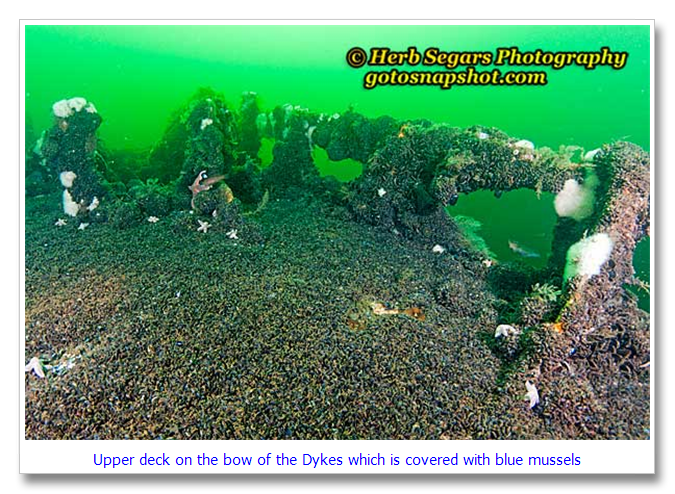
Beth was taking her camera for her second dive with her new strobe. I took my Nikon D300 in a Subal housing with a Tokina 10-17 lens, a Zen 100mm (4”) port and (2) Ikelite DS-125 strobes. Beth would collect the mussels first, put them on a lift bag attached to the anchor line and then go on her way taking photos. We would bring the mussels up at the end of our dive.
The hook was in at the upper side of the bow and when Beth and I reached it, I noticed that visibility was about fifteen feet but there was a lot of stuff in the water column. I knew that this would present a challenge when shooting wide angle. The bottom temperate was 55°. I spent the first part of the dive on the upper part of the bow and shooting bracing that went from one side of the hull internally to the other side of the hull. There is not deck so there is a lot of open area. I spotted lots of blackfish (tautog), black sea bass and bergalls (cunner).
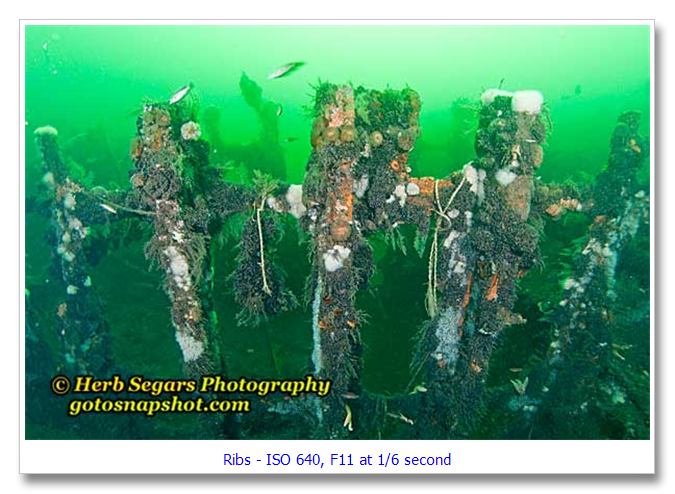
As I moved around the bow, I found an abandoned reef grapple. It was made of rebar and had a PVC tube between the grapple and the tie-in on the anchor line. It looked like the rope had gotten looped around a metal post and that the fishermen could not pull it up. They ended cutting the line as there was about fifty feet of 3/4” diameter line running from the grapple down into the sand.
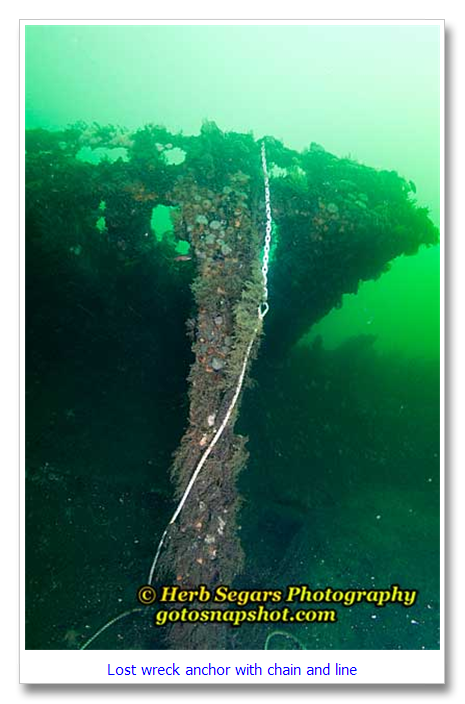
I was trying some new things with the Tokina 10-17mm fish eye lens and the Zen 100mm port. The small port allowed me to get very close to subject and it would look large in the finished photo. I could then have a wide angle background to add interest. Before I did anything, I needed to make some adjustments to balance the available light. I set me lens opening at f11 to get adequate depth of field. I used a shutter speed of 1/10th of a second and then started moving my ISO until I zeroed out the camera’s internal light meter. I set my metering on center weighted rather than matrix or spot metering. I settled on an ISO of 640. It was low enough that I didn’t feel that noise caused by high ISO would be a big factor. I took a few photos and checked the histogram to see how the exposure looked. I saw that I was overexposing slightly and I made some minor changes in shutter speed to compensate.
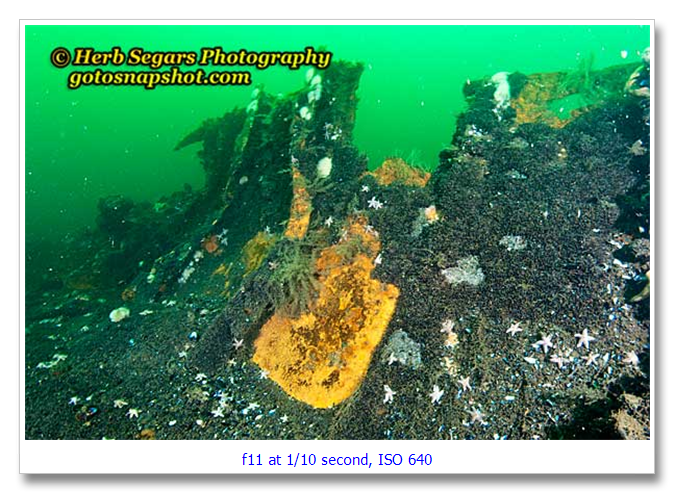
After shooting for awhile at the top of the bow, I dropped down to the sand and headed towards the stern of the ship. I didn’t go very far but I found two abandoned lobster pots and I saw a very big fluke swimming out in a break in the hull. It looked like a flying carpet as it undulated. I followed it out through the opening but when I came around the edge of the hull, the fluke was gone, I would have liked to get a picture of it but I think that it was being extremely wary of me.
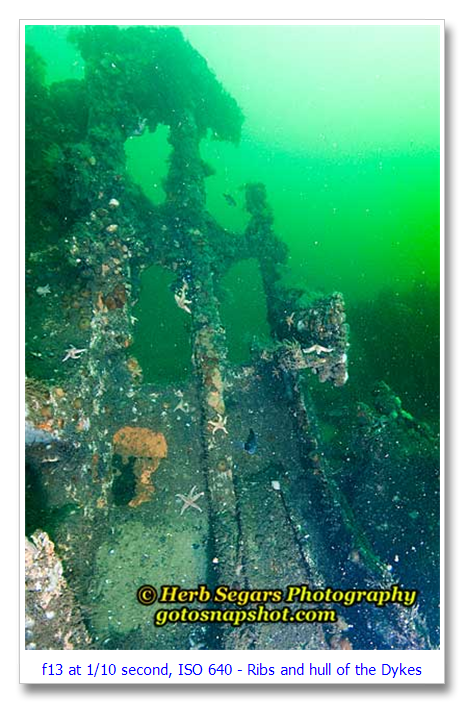
I took some photos of the vertical section of the hull and it’s support ribs and then moved onto some Asteriid and Forbes sea stars. I practiced my close focus wide angle technique with them. The most difficult part of this type of photography is getting the strobes in the right position and getting the right amount of light on the different areas of the photo.
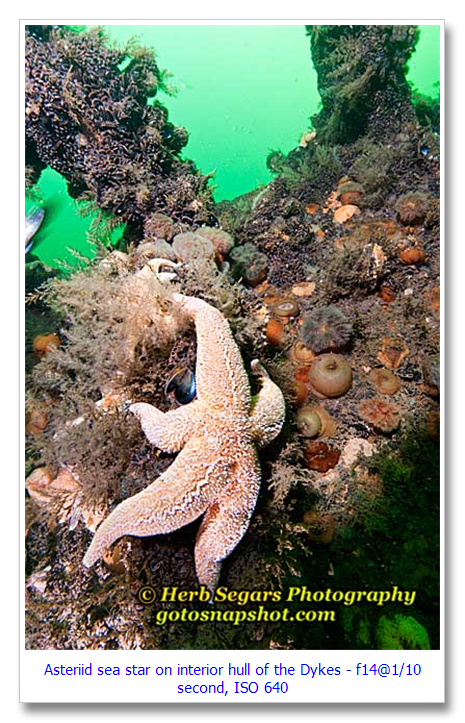
Before I knew it, my air supply was getting low and it was time to head to the surface. Beth and I moved the grapple hook to a spot where it would come out easily and then went up the anchor line with our cameras and our cache of mussels.
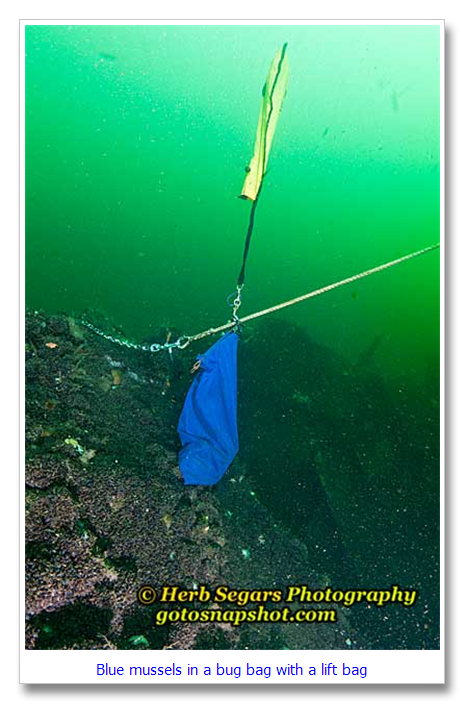
On the surface, Beth, Wes, Veronica and I pulled the mussels apart and put them into a mesh bag that we drag behind the boat on the way in. Dragging the mussels cleans all the debris from the exterior of their shells. By the time that we reached Manasquan Inlet, the mussels were nice and clean. We were back at the dock before noon.
If you would like to see more photos from the Dykes, visit my Photo Gallery and click on Artificial Reef – New Jersey or click here.
© 2010, Herb Segars. All rights reserved.

